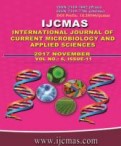


 National Academy of Agricultural Sciences (NAAS)
National Academy of Agricultural Sciences (NAAS)

|
PRINT ISSN : 2319-7692
Online ISSN : 2319-7706 Issues : 12 per year Publisher : Excellent Publishers Email : editorijcmas@gmail.com / submit@ijcmas.com Editor-in-chief: Dr.M.Prakash Index Copernicus ICV 2018: 95.39 NAAS RATING 2020: 5.38 |
Field experiment was conducted in Indira Gandhi Agriculture University, Raipur (C.G.) during Kharif 2015 to Rabi 2017. The experiment field was clayey with neutral pH. The experiment were laid out in split plot design with three replications consisted of pigeonpea and blackgram intercropping under cropping systems and integrated nutrient management viz., C1-Pigeonpea sole (60 x 20cm), C2-Black gram sole (30 x 10 cm), C3-Normal planting of Pigeonpea (60 x 20 cm) + Blackgram (1 row), C4-Paired planting of Pigeonpea (45/75 cm x 20 cm) + Blackgram (2 rows); F0-Absolute control, F1-100 % RDF, F2-50 % RDF, F3-FYM @ 5 t ha-1, F4-100 % RDF + FYM @ 5 t ha-1, F5-100 % RDF+ Rhizobium + PSB + Trichoderma, F6-50 % RDF+ FYM @ 5 t ha-1 and F7-50% RDF+ FYM @ 5 t ha-1+ Rhizobium + PSB + Trichoderma. The result revealed that significantly highest value of yield attributes and yield were recorded under sole pigeonpea (C1) and sole blackgram (C2). Whereas, highest equivalent yield, gross return, net return and B: C were recorded under pigeonpea + blackgram 1:1 (C3). Among the integrated nutrient management, application of 50% RDF+ FYM @ 5 t ha-1+ Rhizobium + PSB + Trichoderma (F7) gave significantly higher yield attributes, yield, gross return, net return and B:C ratio of both crop followed by 100 % RDF + FYM @ 5 t ha-1 (F4), 100 % RDF+ Rhizobium + PSB + Trichoderma (F5).
 |
 |
 |
 |
 |